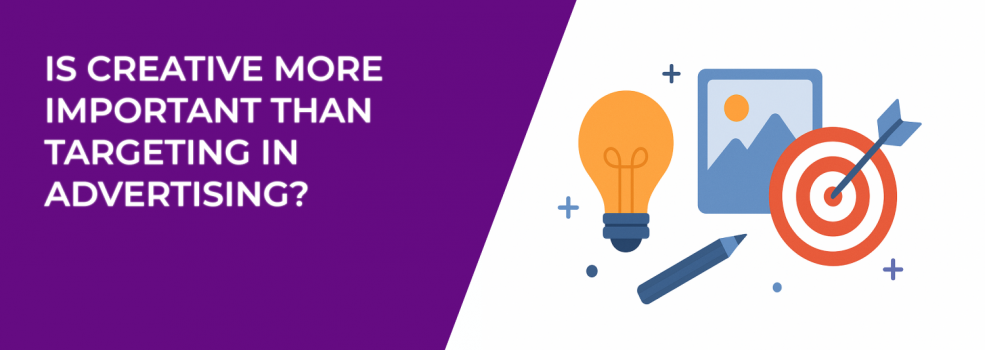Marketers have argued about this for years: what matters more in ads, creative or targeting? Both are important, but one often makes a bigger impact. Let’s break it down.
Why Targeting Still Matters
Targeting is what helps you reach the right people. Without it, you could be showing ads for luxury watches to teenagers or dog food to people who don’t even own pets. That would be a waste.
But here’s the problem. Targeting isn’t as sharp as it used to be. Facebook and Instagram let you pick audiences by interests, behaviors, or demographics. Sounds powerful, right? The reality is a bit messier.
Someone listed as “interested in fitness” might have just liked one workout post three years ago. A “frequent traveler” may have gone on one vacation and hasn’t traveled since. These categories can be fuzzy.
And with privacy updates like Apple’s iOS changes, much of the precise data advertisers relied on is gone. Interests have been removed or made so broad that they don’t always make sense. Micro-targeting doesn’t guarantee results anymore.
So yes, targeting is still useful. It helps cut out obvious mismatches. But depending on it as your main strategy? That’s risky. You may need to rethink your approach and adapt to new targeting realities in 2025.
The Power of Creative
If targeting decides who sees the ad, creative decides what happens next. Creative is the image, video, and message that makes people stop scrolling.
Think about the last ad you noticed. Was it because you were part of some interest category, or because the ad itself grabbed your attention? For most people, it’s the second.
Why creative makes such a difference:
-
You have seconds to stand out. Bold visuals and strong headlines can hook someone instantly.
-
Emotions drive clicks. People respond when ads make them laugh, feel inspired, or picture solving a problem.
-
Creative spreads. No one shares an ad because of its targeting. They share it because it looks or feels great.
These points show why creative often beats targeting. Even when targeting gets you in the right room, creative is what makes people listen.
Tips for better creative:
-
Show the product in action, not just a plain photo.
-
Write simple, clear copy that talks to one person, not a crowd.
-
Test formats — carousel, video, or even interactive polls — to see what clicks.
Using these tips will give your ads a better chance of standing out and driving action. You can also explore different ad formats to make your creative work harder.
Creative vs. Targeting: How They Work Together
Creative and targeting are partners. One without the other rarely wins. Targeting decides who might see the ad, but creative decides if those people will actually care enough to click, sign up, or buy.
The tricky part is that targeting isn’t what it used to be. With fewer precise categories available and data becoming less reliable, creative has to carry more weight than ever. That means advertisers need to think of targeting as the setup, while creative is the punchline.
Imagine two campaigns side by side:
-
Campaign A: The targeting is laser-sharp. You’re reaching exactly the group you want — maybe business travelers who book more than 10 flights a year. But the ad itself? A generic stock photo of an airplane window and a bland line like “Travel smarter with us.” The audience sees it, but barely anyone clicks. Why? Because the creative doesn’t spark any real emotion.
-
Campaign B: The targeting is broader. Instead of focusing only on frequent travelers, you’re reaching anyone with an interest in travel. The ad creative, however, is a short, engaging video that shows the stress of rushing through an airport contrasted with the relief of a smooth booking experience. Even people who aren’t frequent travelers relate to the feeling — and they click, share, or save it.
Campaign B usually performs better. Not because the targeting was perfect, but because the creative connected. Strong creative has a multiplier effect: it can make a wide audience feel like the ad was designed for them. Weak creative, on the other hand, will sink even the most carefully crafted audience strategy.
This is why many advertisers today see targeting as a filter, not the main driver. It points you in the right direction, but creative is what makes the ad land.
Why Creative Has the Edge
The ad world has changed a lot. Privacy rules, iOS updates, and new data restrictions have cut into targeting accuracy. Categories that once felt sharp — like “frequent shoppers” or “parents with young children” — are now:
-
Removed completely.
-
Too broad to be useful.
-
Based on outdated or unreliable signals.
This makes targeting less precise and more of a rough filter.
At the same time, platforms are leaning into automation. Facebook’s Advantage+ campaigns are designed to handle audience selection for you. Instead of carefully hand-picking who to target, you let the algorithm decide.
That shift feels like a loss of control. But it also pushes creative to the front. It’s the part of your ad you can still shape, and it’s what people actually notice.
Here’s why creative now carries more weight:
-
Engagement lowers costs. Ads that earn clicks, likes, and shares get cheaper CPMs.
-
Creative fuels placement. Platforms give better spots in the feed to ads people interact with.
-
Bad creative gets punished. If people scroll past, platforms assume your ad is irrelevant and raise your costs.
So while weak targeting wastes budget, weak creative makes your ads more expensive on top of that.
What should advertisers do?
-
Test visuals regularly — even small changes can make a big difference.
-
Experiment with formats like video, carousel, and stories.
-
Craft messages that connect emotionally, not just logically.
-
Review results often to see what truly resonates.
Once creative is strong, scaling gets easier and more cost-efficient. This connects directly to strategies like scaling without losing performance.
Bottom line: In 2025, creative isn’t just another lever. It’s the one that decides whether your targeting, budget, and even the algorithm work for you or against you.
Striking the Balance
So, how do you combine creative and targeting today?
-
Start broad. Don’t overthink audience settings. Use creative to find out who actually responds.
-
Test, test, test. Try different images, videos, and headlines. Small changes can double your results.
-
Refine with data. Once you know who engages, adjust targeting and make creative just for them.
-
Stay flexible. Audiences shift, platforms change. Don’t rely on one trick.
These steps help you balance creative and targeting without putting all your eggs in one basket. If you’re running campaigns for growth, it also helps to keep your lead generation funnel in mind from the start.
The Bottom Line
So, is creative more important than targeting in advertising? Right now, yes. Targeting still has a place, but it’s no longer the sharp tool it once was. Creative is what gets noticed, shared, and remembered.
If you have limited time or budget, put more into your creative. Build ads that stop the scroll and spark action. Then let targeting do its job as a filter, not the main driver.
Because at the end of the day, people don’t remember targeting settings. They remember the ad.

